|
The Sun
“I have not seen anything like it
in my entire career as a solar physicist”
John Kohl, Harvard-Smithsonian Center for Astrophysics
Until recently, solar activity was considered to be “unprecedented”, because from about 1989 until late 2006, it had been very busy delivering the “New Energy”, but now it seems to be having a rest. The following are some of the most spectacular eruptions from the Sun, but there have been many more!
The Sun: Formation, Facts and Characteristics
|
Here is a short synopsis about the most important object in our solar system.
-
The sun lies at the heart of the solar system, where it is by far the largest object. It holds 99.8 percent of the solar system's mass and is roughly 109 times the diameter of the Earth — about one million Earths could fit inside the sun.
-
The visible part of the sun is roughly 10,000 degrees F (5,500 degrees C), while temperatures in the core reach more than 27 million degrees F (15 million degrees C), driven by nuclear reactions. One would need to explode 100 billion tons of dynamite every second to match the energy produced by the Sun.
-
The sun is one of more than 100 billion stars in the Milky Way. It orbits some 25,000 light years from the galactic core, completing a revolution once every 250 million years or so.
-
The visible part of the sun is roughly 10,000 degrees F (5,500 degrees C), while temperatures in the core reach more than 27 million degrees F (15 million degrees C), driven by nuclear reactions. One would need to explode 100 billion tons of dynamite every second to match the energy produced by the Sun.
-
The sun and its atmosphere are divided into several zones and layers. The solar interior, from the inside out, is made up of the core, radiative zone and the convective zone. The solar atmosphere above that consists of the photosphere, chromosphere, a transition region and the corona. Beyond that is the solar wind, an outflow of gas from the corona.
-
The strength of the sun's magnetic field is typically only about twice as strong as Earth's field. However, it becomes highly concentrated in small areas, reaching up to 3,000 times stronger than usual.
-
When kinks and twists in the magnetic field develop, they create features ranging from sunspots to spectacular eruptions known as flares and coronal mass ejections.
-
Flares are the most violent eruptions in the solar system, while coronal mass ejections are less violent but involve extraordinary amounts of matter — a single ejection can spout roughly 20 billion tons (18 billion metric tons) of matter into space. [NASA have declared that major blasts can amount to half a trillion tonnes of matter.]
-
The sun's magnetic field is inflated by solar wind into a magnetic bubble called the heliosphere more than 10 billion km wide and thus the heliosphere is the biggest object in the solar system. The heliosphere acts as a shield that helps protect the inner solar system from galactic cosmic rays and interstellar clouds.
Source: Space.com
|
|

SPACE.com infographic Click to view
|
Watching The Sun:
|
Our Sun is a remarkably constant star. While some stars exhibit dramatic pulsations, wildly yo-yoing in size and brightness, and sometimes even exploding, the luminosity of our own sun varies a mere 0.1% over the course of an average 11-year solar cycle. However, these apparently tiny variations can have a significant effects and there is a growing realisation that the terrestrial climate is highly sensitive.
Understanding the sun-climate connection requires a breadth of expertise in fields such as plasma physics, solar activity, atmospheric chemistry and fluid dynamics, energetic particle physics, and even terrestrial history. So, due to the increasing impact of space weather, monitoring has been steadily improved since 'The Great Magnetic Storm' in 1989 stunned space scientists with the sudden ferocity of solar activity. Thus with more satellites watching, space scientists have been able to caspture an unprecedented level of detail. The following is a short synopsis.
Three years of Sun in three minutes
In the three years since it first provided images of the sun in the spring of 2010, NASA's Solar Dynamics Observatory (SDO) has had virtually unbroken coverage of the sun's rise toward solar maximum, the peak of solar activity in its regular 11-year cycle. This video shows those three years of the sun at a pace of two images per day.
SDO's Atmospheric Imaging Assembly (AIA) captures a shot of the sun every 12 seconds in 10 different wavelengths. The images shown here are based on a wavelength of 171 Angstroms, which is in the extreme ultraviolet range and shows solar material at around 600,000 Kelvin. In this wavelength it is easy to see the sun's 25-day rotation as well as how solar activity has increased over three years.
|
|
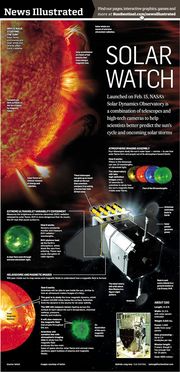
SDO Solar Watch
NASA infographic
Click to view

Three years of Sun in three minutes
Click here
|
The Sun Comes up with a Great Idea: A Light bulb CME!
|
On February 27 2000, an eruption on the Sun was immediately dubbed the “light bulb” CME by SOHO scientists. It shows the three classical parts of this sort of eruption: leading edge, void, and core. To obtain this image the SOHO satellite uses a device called a Large Angle Spectrometric Coronagraph (LASCO).
As the name implies, LASCO provides a wide view of the Sun's corona, it's outer atmosphere. The corona is millions of times fainter than the Sun's photosphere and is therefore only seen on Earth during an eclipse when the Moon blocks the photosphere's light. LASCO mimics an eclipse, simply using a disk to block light from the photosphere, allowing the corona to be observed. Click the “Light Bulb” for larger images and movies of this massive eruption on the Sun.
|
|
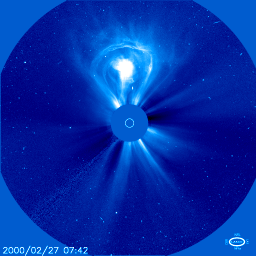
Light Bulb CME
A classical 3-part CME inside the LASCO C3 field of view, showing a bright frontal loop surrounding a dark cavity with a bright core. (LASCO). Credit: ESA/NASA/SOHO
|
Monster Flare on the Sun!
|
In November 2003, during the period known as the “Halloween Storms”, a massive flare erupted on the surface of the Sun, it was so bright that it temporarily blinded the instruments on solar observation satellites. Astronomers believe this was the brightest flare that has ever been seen in modern times. This event created a complete radio blackout of high frequency communications basically anywhere the Sun was shinning at that time. It was eventually rated as a whopping X45, twice as large as any previously recorded flare.
It is believed that if if the accompanying particle and magnetic storm had been aimed at the Earth, the damage to some satellites and electrical networks could have been considerable. Calculations show that the flare's x-ray radiation bombarding the atmosphere was equivalent to that of 5,000 Suns. Luckily, according to researchers, none of it reached the Earth's surface. Click the sun image adjacent for the background story.
|
|
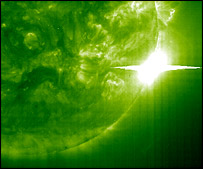
Historic X45 Solar Flare Credit: NASA/ESA/SOHO

NASA | 2003 Halloween Solar Storms Click here
|
The Bastille Day “Full Halo” Coronal Mass Ejection
“On July 14 2000 (Bastille Day), the Sun unleashed a monstrous, long-lasting solar flare and with it a potent swarm of solar particles. A full “halo” coronal mass ejection was shot out from the Sun almost simultaneously, escaping the Sun at nearly 1,800 kilometers per second (4 million miles per hour). The X rays and other light from the blast reached the cameras on SOHO and the flare sensors on the GOES weather satellites about 8 minutes later. Within 15 minutes after the flare, a stream of solar particles began bombarding the Earth’s magnetosphere (moving at half the speed of light). Just 36 minutes after the flare, the ACE spacecraft was bombarded with so many particles that it lost its ability to track solar wind density and velocity. Spacecraft cameras trained on the Sun—from SOHO, TRACE, and Yohkoh— and on the auroral zones of Earth—from Polar and IMAGE—were blinded by the swarm of solar particles. One of the radio transmitters on the Wind spacecraft permanently lost about a quarter of its power, forcing controllers to switch to a backup system. After detecting the initial blast from the Sun, the very satellites that were supposed to monitor the incoming space weather were temporarily blinded by it.”
Excert from Storms from the Sun: The Emerging Science of Space Weather (2002).
Some 31 hours after the Bastille Day flare and the coronal mass ejection from the Sun, the Earth was in the grip of an intense geomagnetic storm. NASA's POLAR satellite false colour images taken at the height of the storm show the intensity of the storm at the Earth's North Pole. Aurora light shows were seen as far south as El Paso, Texas. A Scientific American report called The fury of Space Storms from April 2001 can be found online here.
|
|
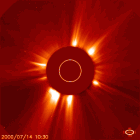
Bastille Day
14 July 2003
Full “halo” CME
Click on the CME animated image for a full report from NASA and for further movies of this historic event click the image below.
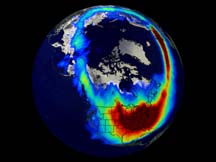 Views of the 'Bastille Day' Sun
|
The Bastille Day Slinky
|
The “Bastille Day” flare image (adjacent) was taken by NASA's Transition Region and Coronal Explorer (TRACE) spacecraft on July 14, 2000. In this closeup, the area covered is about 186,000 miles across, which is large enough to span 23 Earths. The false color image shows a classic “slinky” formation of “magnetic coils” that erupted from the Sun's surface and followed invisible lines of magnetic force in the solar atmosphere. The radiation emitted by the plasma is at about 2.7 million degrees centigrade.
|
|
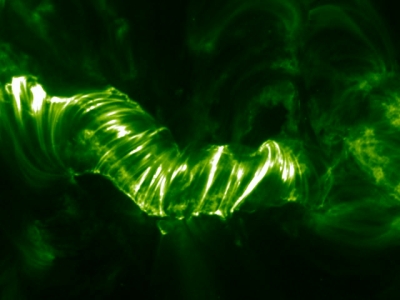 The “Bastille Day Slinky” The “Bastille Day Slinky”
CREDIT: NASA/TRACE
|
Comet Neat and the CME “Reaction” from the Sun
|
In November 2002, a comet appeared as if from nowhere and caused a massive reaction from the Sun. Astronomers were so impressed they called the comet “Neat”. Actually, the Sun’s glare had prevented observers on Earth from viewing NEAT’s approach. But the SOHO spacecraft, stationed between Earth and the Sun, has an instrument called a Large-Angle Spectrometric Coronagraph (LASCO), which blocks the Sun’s brightest light, permitting the satellite to record the comet’s dramatic swing around the Sun. As NEAT raced through the extended solar atmosphere, a large coronal mass ejection (CME) exploded from the Sun and appeared to strike the comet. Click here to get an indepth assessment of this “Neat” event! Click the image to view SOHO animation of this event. Please note this 1.84MB file is slow to load).
|
|
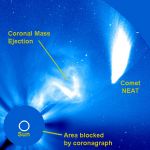
Comet Neat Solar Eruption Credit: NASA/ESA/SOHO
|
Lightning Bolt Solar Flare
|
|
In July 26th 2005, a M-Class Solar Flare looked like a lightening bolt! It was recorded as a sharp spike by the GOES X-Ray Flux satellite which provides a direct indication of solar flare activity. Sun watchers described this unusual solar flare prominence as downright scary!
Watch a slideshow of the most spectacular eruptions from the Sun in recent years at the Joyfire Coronal Mass Ejection (CME) Slideshow.
|
|
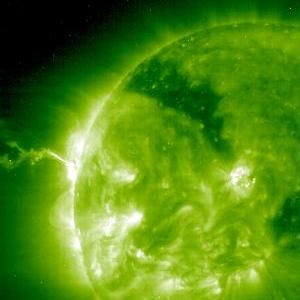
Joyfire CME Slideshow
|
Get The Sun Facts
|
|
The biggest outburst on the Sun in 30 years took place on 5/6th December 2006, you can find out what happened at the Joyfire webpage Sun Facts. Here, you can find more information and watch the Sun at the Space Weather Explorer window.
|
|
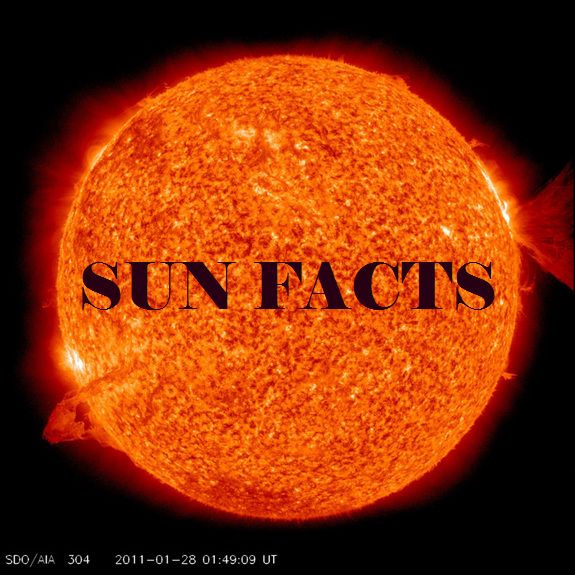
Click for Joyfire Sun Facts
|
Joyfire Tour Back
  Next
|

